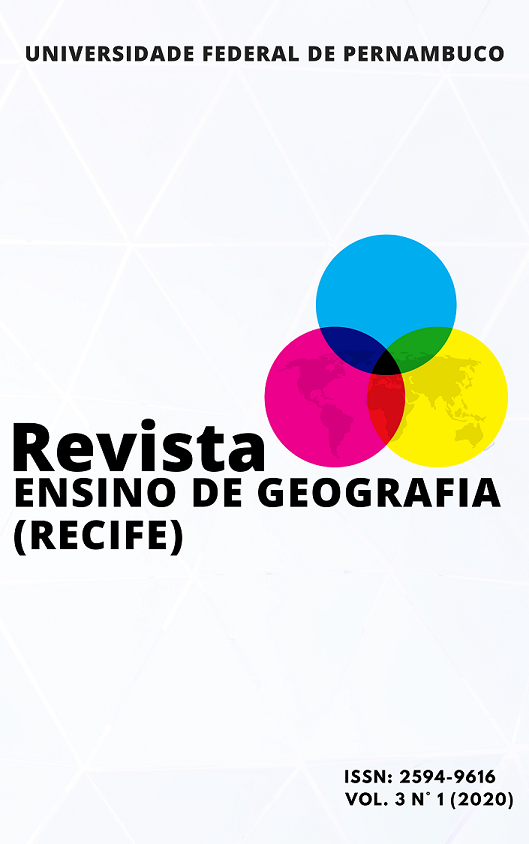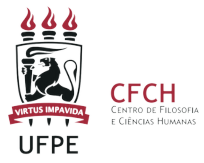Excursions and field class in geography: a different view about the semi-arid
DOI:
https://doi.org/10.51359/2594-9616.2020.244684Keywords:
Landscape analysis, Caatinga, Northeaster, FieldworkAbstract
The semiarid has approximately 1,120,000 km², distributed among 1,262 municipalities. Although it is often treated as a dry and adverse environment, the semiarid has a wide diversity of natural, historical and cultural elements, and economically developed areas. The present work aims to demonstrate the relationship between society and nature, and the natural and cultural landscape diversity of the semiarid through excursions involving field classes. The excursion involved students and teachers of geography graduation (full degree). The municipalities of Juazeirinho, Patos and Sousa, municipalities of Paraíba state, Brazil, were visited. Several subjects were discussed in a practical way, such as Caatinga, climate, geology, geomorphology, paleontology, water resources and economy of semiarid. The practical activities of excursions involving field classes proved to be of fundamental importance for the professional training in geography, allowing the development of new concepts, new perspectives and critical thoughts of various themes involving the Northeastern semiarid
References
AB'SABER, A. N. O domínio morfoclimático semi-árido das caatingas brasileiras. Geomorfologia, n. 43, p. 1-39, 1974.
ABRIL-SELLARÉS, M.; CRIADO, M. C. A.; SÁNCHEZ-FERNÁNDEZ, M. D. Análisis del viaje como uno de los ejes transformadores del proceso educativo. Universitas, v. 30, p. 63-78, 2019.
ALENTEJANO, P. R. R.; ROCHA-LEÃO, O. M. Trabalho de campo: uma ferramenta essencial para os geógrafos ou um instrumento banalizado? Boletim Paulista de Geografia, v. 84, p. 51-67, 2006.
ANDRADE, M. C. A terra e o homem no Nordeste: contribuição ao estudo da questão agrária no Nordeste. 8 ed. São Paulo: Cortez, 2005. 336p.
AZAMBUJA, L. D. Trabalho de campo e ensino de Geografia. Geosul, Florianópolis, v. 27, n. 54, p. 181-195, 2002.
BRASIL. Programa de Ação Nacional de Combate à Desertificação e Mitigação dos Efeitos da Seca/PAN-Brasil. Brasília (DF): Ministério do Meio Ambiente/Secretaria de Recursos Hídricos, 2004. 214p.
COMPIANI, M.; CARNEIRO, C. D. R. Os papéis didáticos das excursões geológicas. Enseñanza de las Ciencias de la Tierra, v. 1, n. 2, p. 90-97, 1993.
CORDEIRO, J. M. P.; OLIVEIRA, A. G. A aula de campo em geografia e suas contribuições para o processo de ensino-aprendizagem na escola. Geografia (Londrina), v. 20, n. 2, p. 99-114, 2011.
CORRÊA, M. M.; KER, J. C.; MENDONÇA, E. S.; RUIZ, H. A.; BASTOS, R. S. Atributos físicos, químicos e mineralógicos de solos da região das várzeas de Sousa (PB). Revista Brasileira de Ciência do Solo, v. 27, n. 2, p. 311-324, 2003.
GOMES, J. F.; LUNA, V. F.; SILVA, M. O.; RIBEIRO, S. C. A importância da aula de campo como metodologia de ensino de Geomorfologia do Semiárido: relato de experiência nos sertões da Paraíba e do Rio Grande do Norte. Revista da Casa da Geografia de Sobral (RCGS), v. 21, n. 2, p. 784-794, 2019.
JESUS, M. C. S.; SANTOS, M. F. A aula de campo no ensino da geografia: experiências cotidianas na cidade para construção de aprendizagens. Revista Ensino de Geografia (Recife), v. 2, n. 1, p. 186-197, 2019.
LACOSTE, Y. A pesquisa e o trabalho de campo: um problema político para os pesquisadores, estudantes e cidadãos. Boletim Paulista de Geografia, v. 84, p. 77-92, 2006.
LAMBERT, D.; REISS, M. J. The place of fieldwork in geography qualifications. Geography, v. 101, n. 1, p. 28-34, 2016.
LEITÃO, J. A.; SANTOS, M. S. T. Imagem jornalística e representações sociais: a imagem dos Sertões. Intercom (São Paulo), v. 35, n. 1, p. 133-155, 2012.
LEONARDI, G.; CARVALHO, I. S. Icnofósseis da Bacia do Rio do Peixe, PB: o mais marcante registro de pegadas de dinossauros do Brasil. In: SCHOBBENHAUS, C.; CAMPOS, D. A.; QUEIROZ, E. T.; WINGE M.; BERBERT-BORN, M. L. C. (edts.). Sítios geológicos e paleontológicos do Brasil. Departamento Nacional de Produção Mineral (DNPM), 2002. p. 101-111.
MARENGO, J. A.; ALVES, L. M.; BESERRA, E. A.; LACERDA, F. F. Variabilidade e mudanças climáticas no semiárido brasileiro. In: MEDEIROS, S. S.; GHEYI, H. R.; GALVÃO, C. O.; PAZ, V. P. S. (Orgs.). Recursos hídricos em Regiões Áridas e Semiáridas. INSA, Campina Grande, pp. 383- 416, 2011.
MARTIN, R. E. M. W. Os desafios na construção dos saberes docentes do professor de geografia. Linguagens, Educação e Sociedade, v. 1, n. 33, p. 63-78, 2017.
MIZAMBAEVA, F. K.; BAIMYRZAEV, K. M. Conditions for the formation of professional competence of an intending geography teacher. Revista Espacios, v. 40, n. 09, 2019.
MOREIRA, E. R. F.; TARGINO, I. Capítulos de geografia agrária da Paraíba. Editora Universitária/UFPB: João Pessoa, 1997. 332p.
OLIVEIRA, C. D. M.; ASSIS, R. J. S. Travessias da aula em campo na geografia escolar: a necessidade convertida para além da fábula.
Educação e Pesquisa, v. 35, n. 1, p. 195-209, 2009.
QUEIROZ, L. P.; CARDOSO, D.; FERNANDES, M. F.; MORO, M. F. Diversity and evolution of flowering plants of the Caatinga domain. In: SILVA, J. M. C.; LEAL, I. R.; TABARELLI, M. (edt.). Caatinga: the largest tropical dry forest region in South America. Springer International Publishing: Amsterdam, 2017, p. 23-63.
SANTOS, W. F. S.; CARVALHO, I. S.; BRILHA, J. B.; LEONARDI, G. Inventory and assessment of palaeontological sites in the Sousa Basin (Paraíba, Brazil): preliminary study to evaluate the potential of the area to become a geopark. Geoheritage, v. 8, n. 4, p. 315-332, 2016.
SILVA, J. M. C.; BARBOSA, L. C. F.; LEAL, I. R.; TABARELLI, M. The Caatinga: understanding the challenges. In: SILVA, J. M. C.; LEAL, I. R.; TABARELLI, M. (edt.). Caatinga: the largest tropical dry forest region in South America. Springer International Publishing: Amsterdam, 2017, p. 03-19.
SILVA, J. M. C.; BARBOSA, L. C. F. Impact of human activities on the Caatinga. In: SILVA, J. M. C.; LEAL, I. R.; TABARELLI, M. (edt.). Caatinga: the largest tropical dry forest region in South America. Springer International Publishing: Amsterdam, 2017, p. 359-368.
SILVA, E. J.; COUTINHO, D. J. G. A excursão geográfica como recurso didático no ensino de geografia. Brazilian Journal of Development, v. 5, n. 12, p. 31667-31675, 2019.
SILVA, S. D. R.; MASSUCHIN, M. G. Construção do Nordeste no telejornalismo: um estudo do Jornal Hoje. Revista Extraprensa, v. 13, n. 1, p. 185-207, 2019.
SILVA, J. M. C.; BARBOSA, L. C. F.; LEAL, I. R.; TABARELLI, M. The Caatinga: understanding the challenges. In: SILVA, J. M. C.; LEAL, I. R.; TABARELLI, M. (edt.). Caatinga: the largest tropical dry forest region in South America. Springer International Publishing: Amsterdam, 2017, p. 03-19.
SOUSA, J. D.; LIMA, D. C.; BRITO, F. C. S.; MEDEIROS, A. P.; PAIVA, A. C. C.; MARACAJA, P. B. O desenvolvimento da região Nordeste: uma abordagem econômica e ambiental. Revista Brasileira de Gestão Ambiental, v. 11, n. 1, p. 42-48, 2017.
SUDENE - SUPERINTENDÊNCIA DE DESENVOLVIMENTO DO NORDESTE. Nova delimitação Semiárido. Resolução CONDEL nº 107, de 27/07/2017 e nº 115, de 23/11/2017. Ministério da Integração Nacional, 2018. Disponível em: http://www.sudene.gov.br Acesso em: 03 Novembro 2019.
SUERTEGARAY, D. M. A. Pesquisa de campo em geografia. GEOgraphia, v. 4, n. 7, p. 64-68, 2002.
TRAVASSOS, I. S.; SOUZA, B. I.; SILVA, A. B. Secas, desertificação e políticas públicas no semiárido nordestino brasileiro. Okara: Geografia em debate, v. 7, n. 1, p. 147-164, 2013.
TRICART, J. O campo na dialética da geografia. GEOUSP: Espaço e Tempo (Online), v. 21, n. 1, p. 305-314, 2017.
VENTURA, A. C.; GARCIA, L. F.; ANDRADE, J. C. S. O potencial das tecnologias sociais de convivência com o semiárido para a geração de sinergia entre mitigação e adaptação às mudanças climáticas: um caso ilustrativo. Revista Econômica do Nordeste, v. 50, n. 1, p. 65-83, 2019.
Downloads
Published
How to Cite
Issue
Section
License
Copyright (c) 2021 Thiago dos Santos Dantas, Joel Maciel Pereira Cordeiro

This work is licensed under a Creative Commons Attribution 4.0 International License.
Authors who publish with this journal agree to the following terms:- Authors retain copyright and grant the REVISTA ENSINO DE GEOGRAFIA (RECIFE) right of first publication with the work simultaneously licensed under a Creative Commons Attribution NonCommercial International 4.0 (CC BY-NC) that allows others to share the work with an acknowledgement of the work's authorship and initial publication in this journal.
- Authors are able to enter into separate, additional contractual arrangements for the non-exclusive distribution of the journal's published version of the work (e.g., post it to an institutional repository or publish it in a book), with an acknowledgement of its initial publication in this journal.
- Authors are permitted and encouraged to post their work online (e.g., in institutional repositories or on their website) prior to and during the submission process, as it can lead to productive exchanges, as well as earlier and greater citation of published work.



